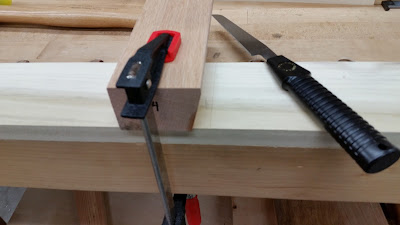I continued cutting tenons for all of the mortises I did previously. Additionally, I cut the dovetails for the upper web frame. These seat into the top of each leg and into the upper rail on the short side of the carcase.
 |
| Dovetail tenons on the upper web frame. |
 |
| Upper frame dovetailed into place. |
 |
| Front of lower web frame. Double mortise & tenon not fully seated. |
This piece provided some excellent joinery practice. There ended up being 48 mortise & tenon joints, 8 dovetail tenons, and two sliding dovetails. There will probably be about 24 pocket screws added for good measure.
 |
| Sliding dovetail setup. |
Thanks to
treebangham's YouTube video on how he does sliding dovetails. The flush-cut saw leaves an almost glassy finish on the walls of the dovetail socket. I used some oil to keep the saw from binding in the cut.
 |
| Upper sliding dovetail. |
I was able to get a respectable fit on the sliding dovetails. I think they will go together about right when I add glue.
 |
| All interior framing in place. |
I used 1/2" Baltic birch plywood for the panels and rabbeted them on the table saw since the grooves in the frame were only 1/4".
 |
| With 1/2" Baltic birch panel (technically 12mm) |
I used a router bit sized for 1/4" plywood to cut the grooves in the lower web frame to accept the bottom panels. This plywood ended up being too thick to fit the grooves so I beveled the bottom slightly with a block plane to make it thinner around the edges. Problem solved.
 |
| Bottom panels in place. |
I still needed to figure out how to attach the brackets or corbels. I ended up using lag screws with large diameter heads. Poplar is fairly soft and I didn't want the heads to sink into the wood.
 |
| Spax screws. |
 |
| Screws from inside the cabinet. |
 |
| With corbels installed. |
Now for lots of sanding. This thing is too big for me to carry back and forth to my pop-up tent / paint booth, so I'll try to prime and paint as much as possible before final assembly. Once it's assembled, I'll get someone to help me move it into the paint tent for the final coat of paint.
To be continued ...

















